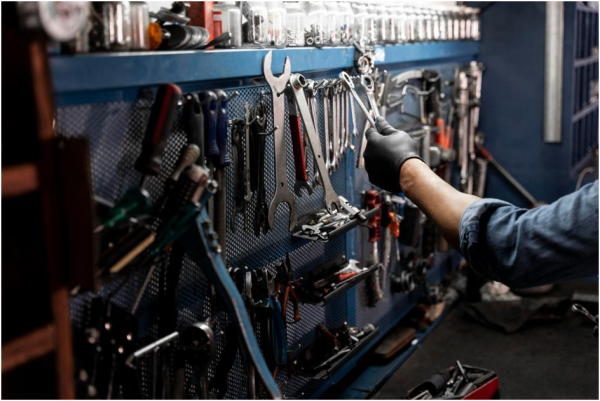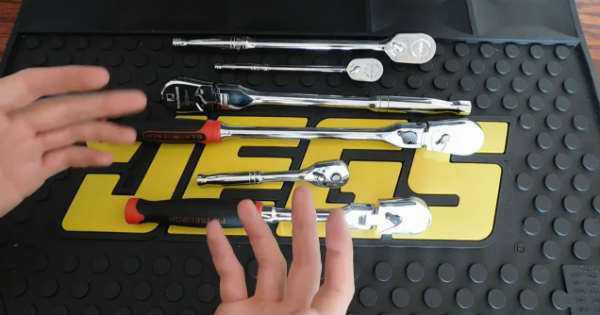Maintaining an orderly garage workshop, complete with well-organized tool storage, significantly enhances the ease and efficiency of repair and maintenance projects. By providing secure and easily accessible designated storage spots for instruments and equipment, you’ll save time and frustration each time you need to locate a 10mm socket or your favorite ratchet. Here are some guidelines to effectively organize and store mechanic tools in your garage workshop. By implementing these tips, you can enhance productivity, ensure safety, and maximize your enjoyment of the space.

Consider Accessibility and Visibility When Choosing Storage Locations
One crucial aspect to consider when determining the ideal storage location for your workshop tools is accessibility. Keep frequently used stuff in close proximity to a mechanic workbench or project area. This arrangement enables quick access without the need for constant movement back and forth within the garage. Enhance workflow by strategically placing panels, pegboards, shelves, and storage chests in convenient areas.
Visibility is crucial for efficient retrieval. Opt for transparent plastic containers, open shelves, or shadow boards with designated tool outlines for easy identification and quick access. Avoid using closed canvas tool bags or cluttered drawers that lead to unnecessary rummaging and time wastage.
Ensure that the workshop is well-lit to provide adequate lighting in every storage area, ensuring tools are easily visible. Additional lighting may be required near workbenches. Implementing signs and labels will assist in identifying stored items from a distance.
By strategically organizing your tools according to how often you use them and how visible they need to be, you can save valuable time on each project and eliminate the frustration of searching for them. Keep commonly used instruments like screwdrivers, pliers, and adjustable wrenches in clearly labeled drawers near your primary workstation. For power tools that are used less frequently, store them in higher or less accessible areas, away from the main workflow path.
Use Durable Storage Materials to Protect Tools
The storage solutions you select should also safeguard your tool collection from harm, corrosion, moisture, and debris. Seek out robust metal tool chests, cabinets, and workbenches to securely store your equipment. Dependable wall mounts, racks, and pegboards will effectively hold your tools for extended periods. Stackable toolboxes offer excellent portability and allow for the separation of specialty tools.
Use drawers with felt lining, foam inserts, bins, and protective cases to prevent the jostling of small objects such as drill bits, nuts, bolts, and screws. This practice ensures organized storage and protects these items from any damage. Hang stuff like hoses and cables from hooks to prevent any kinks.
Certain precision instruments such as digital calipers and torque wrenches require additional safeguarding to preserve their calibration. Store them in protective cases on a shelf, rather than casually tossing them into a drawer. Preventing rust can be achieved by laying down moisture-sensitive electrical tools. The workshop can also benefit from the installation of dehumidifiers to regulate humidity levels.
Incorporate Various Safety Features
A properly planned workshop should prioritize safety by implementing effective tool storage techniques. Begin by securely storing valuable power tools such as miter saws, grinders, and drills in a locked cabinet, chest, or designated tool room to deter theft. Lockable rollaway carts are highly recommended for convenient mobility while ensuring the security of the tools.
Use straps, rails, hooks, and fasteners to secure top-heavy items stored at elevated heights, preventing them from toppling over. Display relevant safety warnings such as “Flammable” or “Sharp Edges” in appropriate locations as a reminder for yourself and others to exercise caution. Install fire extinguishers and first aid kits in highly visible areas for easy access in case of emergencies.
Ensure that your mechanic tools are not stored in areas that hinder shop access or obstruct emergency systems such as electrical panels, emergency stops, and fire extinguishers. Maintain sufficient walking space in the center and around workstations. Neatly coil or hang hoses to eliminate tripping hazards. Keep the workshop area organized by promptly returning tools to their designated storage after each use.
Maintaining Your Storage System
Establish a maintenance timetable to regularly examine and maintain your workshop storage solutions. Prior to storing them, ensure that you clean your tools to eliminate any grease, dirt, or chemicals that may lead to deterioration. Regularly inspect for signs of rust or damage that require attention and repair.
Over time, storage cabinets may require new shelving, drawers may deform or crack, and pegboards may weaken. Replace any components as necessary to ensure the secure storage of your tools. Reorganize your workspace when acquiring new tools or switching between tasks. Continuous improvement of accessibility is crucial to maintaining an efficient workshop environment.
Consider creating a digital catalog of your tool collection by using photos or QR codes. This approach allows for faster inventory management and helps identify missing or misplaced tools, preventing disorganization. Remember, proper tool storage is an ongoing process that should adapt to your changing needs.
Implement Storage Best Practices for a Safer, More Efficient Workshop
A well-structured workshop begins with appropriately planned storage solutions to ensure the safety and accessibility of your tools and equipment. By strategically placing them based on usage frequency, visibility, and ergonomics, you can save valuable time on your projects. Consider investing in reliable and durable storage options such as metal chests, cabinets, and workbenches to safeguard your valuable gear for the long run.
Ensure the safety of your storage plan by incorporating features such as locks, straps, warning signs, and an extinguisher. Keep your workshop tidy by always returning tools to their designated places when not in use. Regularly inspect and maintain storage items to address any issues before they escalate.
Having a well-organized workshop is crucial for enhancing efficiency, safety, and overall satisfaction. By implementing these solutions, you can make your time working on vehicles more enjoyable. Following the right organizing principles will help maintain your shop’s optimal condition for years to come.

